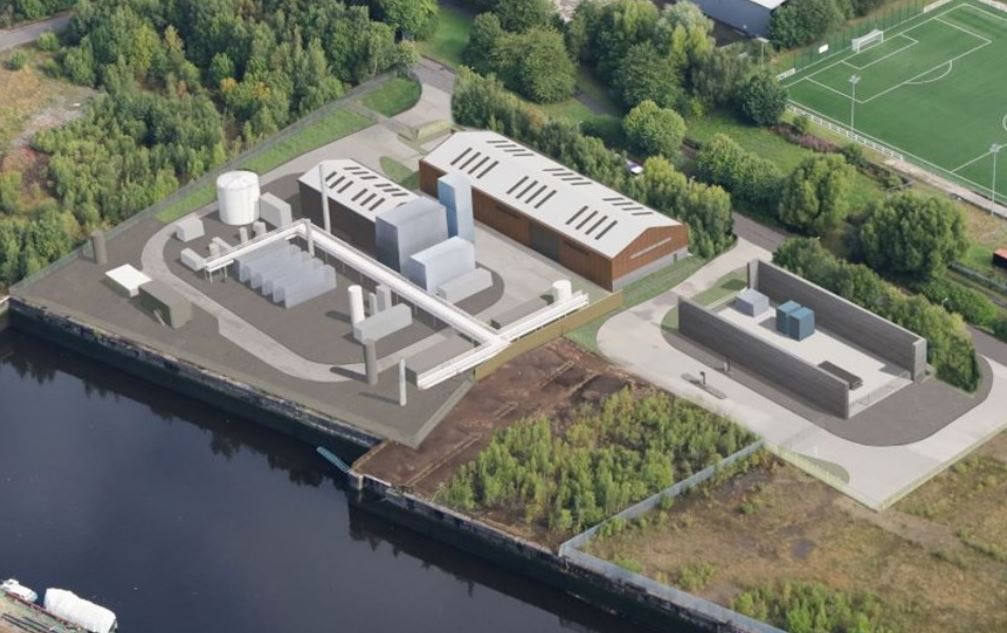[ad_1]
Peel NRE, a part of United Kingdom-based Peel L&P, is building a new $24 million (£20 million) plant in West Dunbartonshire, Scotland that will turn plastic waste into hydrogen. The company says it will use new tech to “create a local source of sustainable hydrogen from non-recycling plastics otherwise destined for landfill, incineration or export overseas,” reports The BBC. The hydrogen will then be utilized to fuel cars, buses, and HGVs. There are plans to build a hydrogen refueling station on the plant’s site.
“The facility will address the dual challenge of both tackling our problem plastic whilst creating hydrogen, a sustainable fuel for future generations,” said Richard Barker, development director at Peel NRE, in a press release. “Whilst the focus must remain on removing plastic from society, there are still end of life plastics that need managing. The £20m plant will play a pivotal role in making the best use of non-recyclable material, with the resulting hydrogen able to help cut carbon emissions from vehicles.”
This particular facility uses technology from Powerhouse Energy Group, which it calls “Distributed Modular Generation, our proprietary advanced thermal conversion technology, which we employ to produce electrical power and hydrogen from waste plastics.”
Powerhouse Energy Group explained how it works:
“DMG is in fact a sub-stoichiometric, endothermic gasification process. Whereby a significant amount of heat is applied to the waste plastics. This causes them to break down into their constituent molecules, and through a series of endothermic chemical reactions, turn into energy-rich syngas.”
It noted that “a typical plant will process approximately 40 tonnes of waste plastic per day and produce up to 2 tonnes (2000kgs) of hydrogen in the same period. This equates to approximately 50 kg of H2 for every tonne of feedstock.”
This raises the question: What happened to the other 38 tonnes? Here, we have to look again at what syngas actually is made of and how you turn it into hydrogen. Syngas is a mix of carbon monoxide and hydrogen, usually made from methane in natural gas through steam reforming as a step in the process of generating hydrogen for ammonia production. In chemical notation:
CH4 + H2O → CO + 3H2
To separate the hydrogen from the CO, you add more steam and get, guess what, carbon dioxide.
CO + H2O → CO2 + H2
OK then, what happens to the carbon dioxide (CO2)? In another hydrocarbon to hydrogen project we have discussed—the Quest project in Alberta—the CO2 is piped away and sequestered underground. That was the whole point of the project, the definition of “blue” hydrogen.
Here, they don’t quite say, but do note that “DMG facilities can be built ready to include Carbon Capture for utilization or storage.” Since they don’t mention this wonderful feature, I suspect they are just venting the CO2 into the atmosphere.
Plastic is basically a solid fossil fuel and that is what this plant is running on. They are using pyrolysis, or heating plastic to extremely high temperatures to make the syngas, which they are then turning into hydrogen and CO2. The point of it all, as we have said about chemical recycling before, is to make plastic waste disappear in a feel-good exercise, which turning 40 tons of waste into 2 tons of hydrogen plus a whole lot of CO2 essentially is.
I reached out to hydrogen expert Paul Martin of the Hydrogen Science Coalition for his thoughts, asking: “They get 2 tonnes of hydrogen out of 40 tonnes of plastic. That seems awfully inefficient, and what happens to the other 38 tonnes? Is this all a scam?” He tells Treehugger:
“Yes, it’s a scam. You gasify plastic to make syngas, and dump the CO2 to the atmosphere. Plastic is a fossil fuel as is any fuel derived from it or from its energy content, and waste plastic is easily and permanently sequestered merely by burying it.” He also told Treehugger that the residue, the ash, would be an issue. “Any quantity of F, Cl, or Br in the feed plastic (from fluoropolymers, PVC or brominated fire retardants) will end up making nastiness whether you burn it or pyrolyze or gasify it.”
This is the problem with this process is that it is no different than old-fashioned recycling: It is all designed to make us feel good about buying disposable plastic packaging. They can’t bury it anymore, they can’t ship it to China anymore, and conventional incineration is too obvious. Now they can make it go poof into a cloud of CO2 and a squirt of hydrogen and everyone is happy.
But ultimately, realistically, the only way to make plastic waste disappear is to stop generating it in the first place. Everything else is just smoke and mirrors.
[ad_2]
Source link
